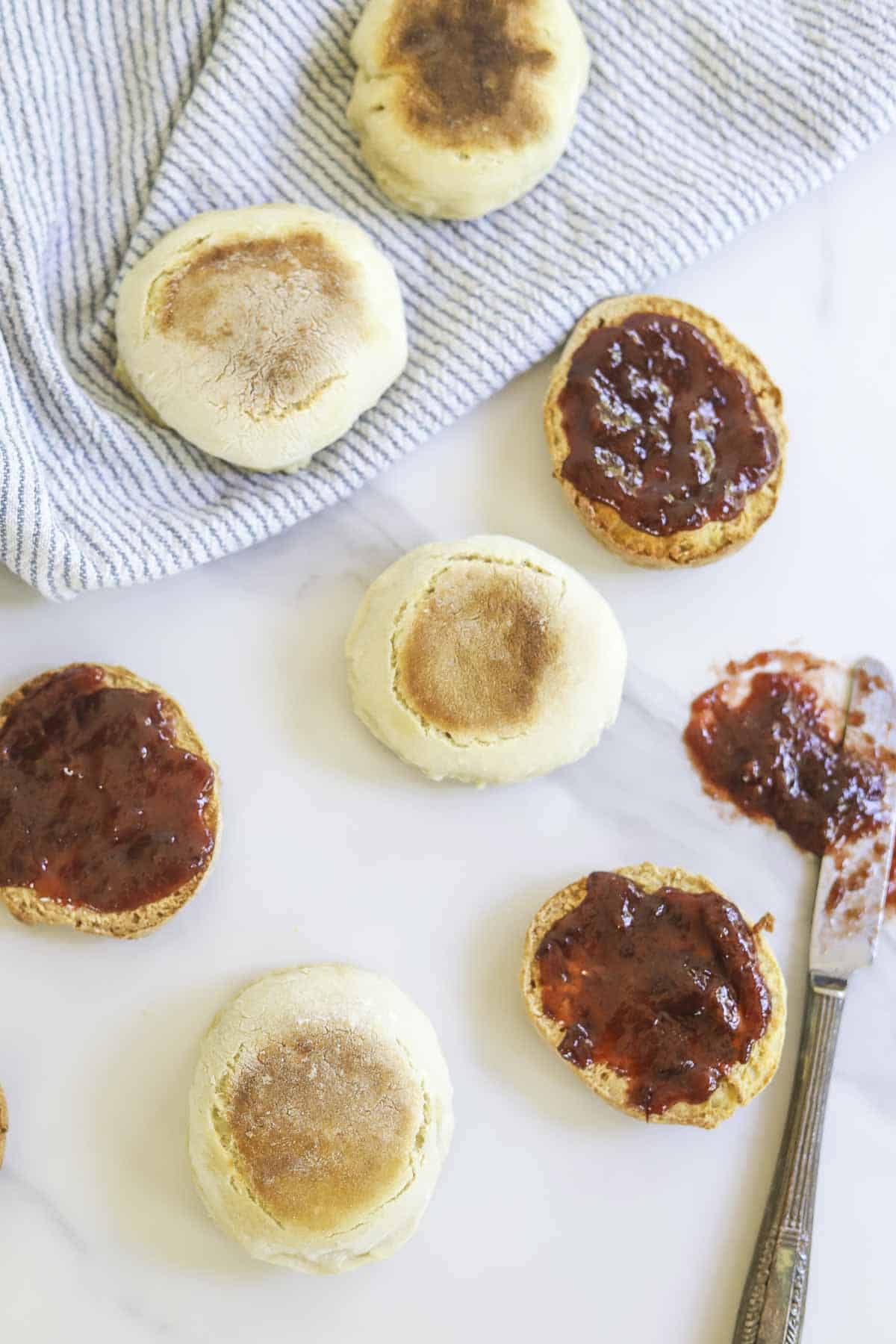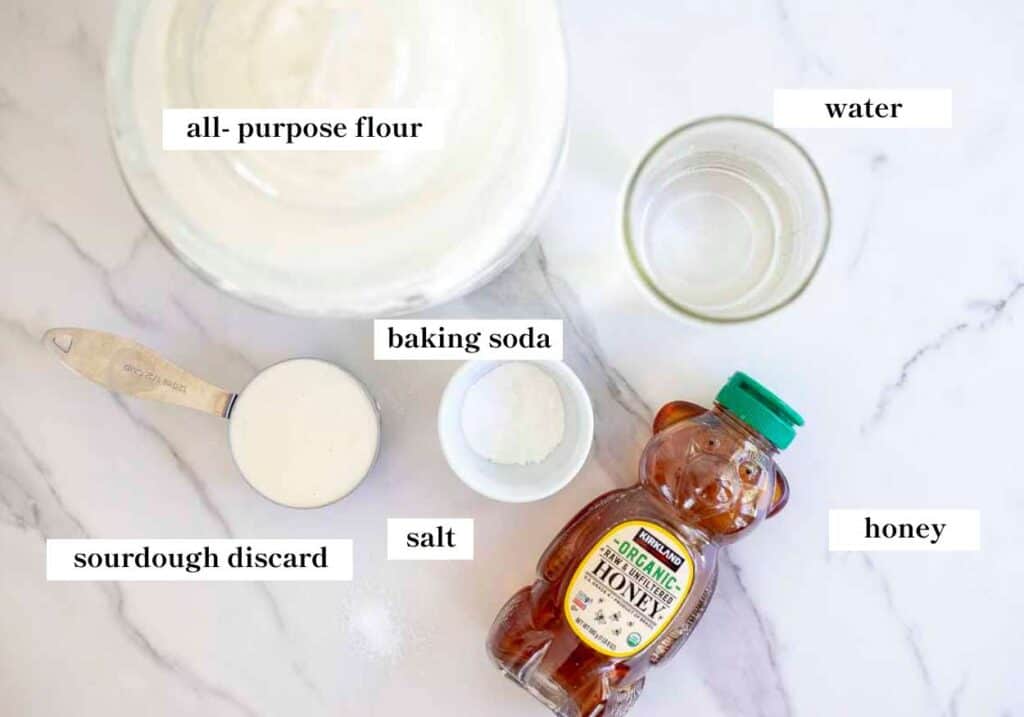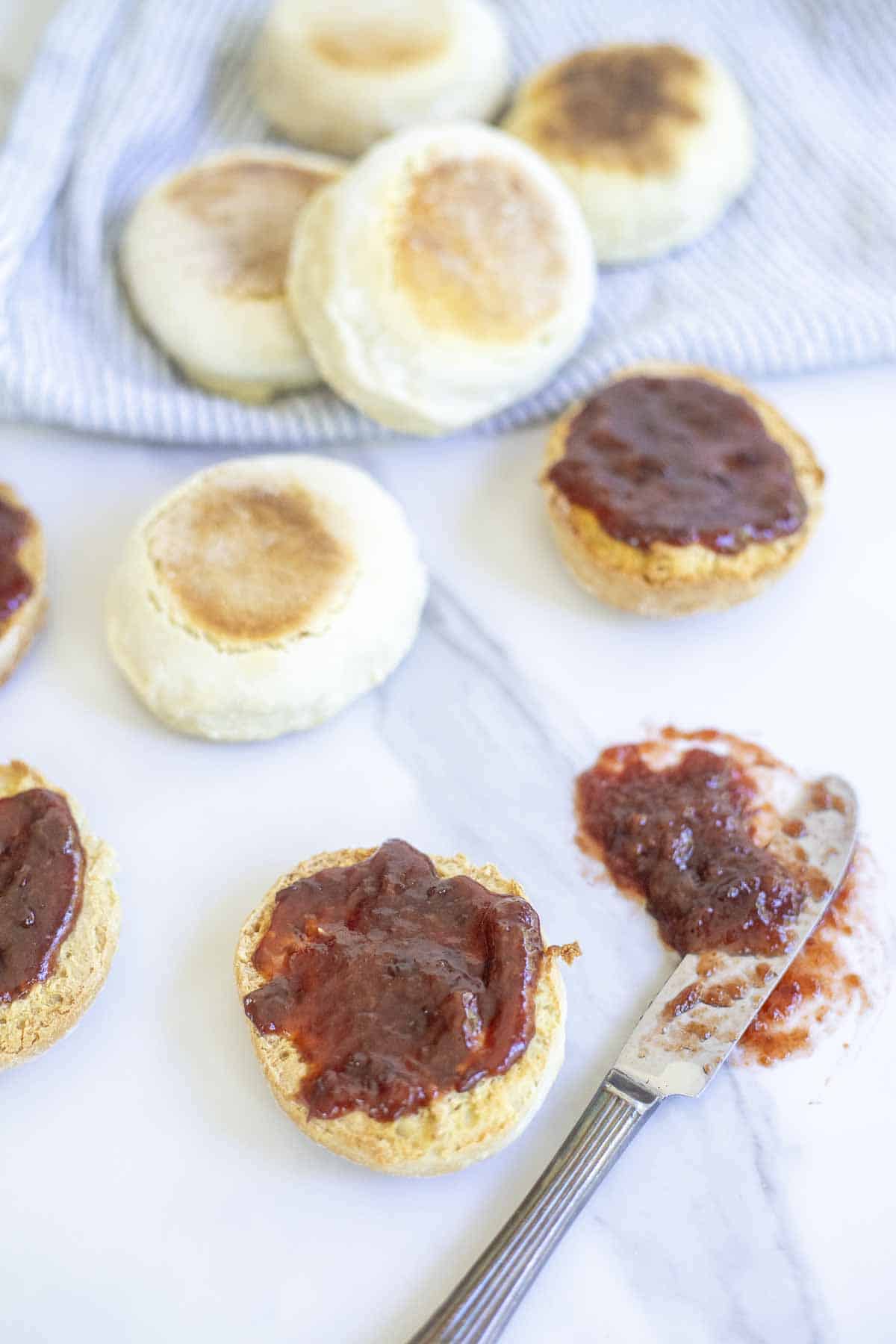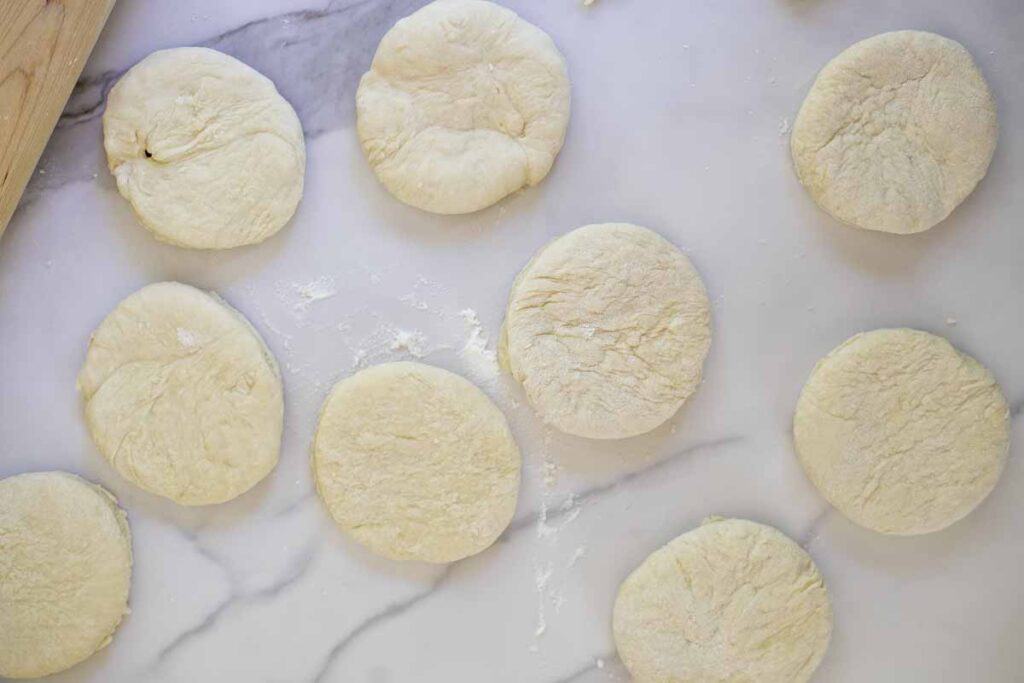All you need is a few simple ingredients to make these delicious and soft sourdough discard English muffins. Delightfully chewy, this recipe makes the perfect breakfast, brunch, or even use them in place of bread in sandwiches.

This post contains affiliate links, which means I make a small commission at no extra cost to you. See my full disclosure here.
The original version of my sourdough English muffins were one of my very first sourdough recipes on the blog. They are a staple in our house. They are super simple to make, they come together quickly, and you can use them in just about a thousand ways.
Most of the ingredients you probably already have in your pantry, and if you are new to sourdough baking, this is for you.
Sourdough bread can be intimidating. You worry about the timing, and about feeding your starter so it is active when you are ready to start the dough. It’s one reason many people don’t even try. They are overwhelmed with all the new things they may have to learn.
If that is you, I want to encourage you to keep going. Start with sourdough discard recipes, like double chocolate sourdough bread, and once you get your feel for it, move on to some active starter fermentations.
Why You’ll Love This Recipe

Great way to use discard: No, you don’t need an active sourdough starter for this recipe (although that will work). Discard will work just fine because the dough is risen by baking soda rather than the wild yeast in the active starter.
Versatile: English muffins can be used in a variety of ways– no need to stick to just breakfast. I use them for sandwiches or even as a side instead of biscuits. Slather on some homemade strawberry jam or cream cheese and everyone will be happy.
Super simple: They can be made quickly or long-fermented for the added health benefits.
Ingredients

Sourdough discard: The star of the show. This is an unfed sourdough starter. Active starter will also work, but it’s not a requirement. Discard also adds a lovely tanginess to the dough. Learn how to make a sourdough starter.
Honey: You could also use maple syrup or even sugar. You may need to add a little water if using sugar.
Baking soda: This gives the dough its rise.
Tools You May Need
Cast iron skillet
English muffin rings, biscuit cutter, round cookie cutter, or even just a mason jar ring
How to Make Sourdough Discard English Muffins

The Quick Version

Step 1: Heat a large cast iron skillet over medium-low heat. Add flour, salt, and baking soda to a large bowl. Whisk together well.

Step 2: Add in water and sourdough starter discard. Mix until it comes together. You could use a stand mixer if you prefer.

Step 3: Knead the dough for a few minutes to help develop the gluten strands.

Step 4: Roll dough out on a lightly floured surface about 1/2 inch thick with a rolling pin. Use an English muffin cutter and cut out the dough. Continue rolling out and cutting dough until all the dough is used up.

Step 5: Add a little oil to the cast iron skillet. Place English muffins in the pan. Allow to cook for about 5-6 minutes on one side.

Step 6: Flip and continue cooking for another 5-6 minutes. Allow to cool, then serve. If they have not cooked all the way through, place them in a 350 degree oven for a few minutes.
The Long-Fermented Version
Step 1: In a large bowl, mix all of the ingredients minus the baking soda. Knead together for a few minutes. Cover with plastic wrap or a lid and allow to sit at room temperature for 8-12 hours.
Step 2: The next day, add baking soda to the fermented dough and knead well, making sure it’s all incorporated. Roll the dough and cut out. Preheat the skillet on medium-low heat.
Step 3: Add the English muffins to the cast iron skillet. Cook for about 5-6 minutes on one side, then flip and continue cooking for another 5-6 minutes. Allow to cool, then serve.
Tips
- If your dough is too dry, you may need to add a little more water. The hydration of your starter will play a big part in this.
- If you find that the homemade English muffins are not cooking all the way through, you may need to pop them into a 350-degree Fahrenheit oven and allow them to finish cooking.
- Make sure to use fresh baking soda for best results. Old baking soda may not give these muffins the desired rise.
- If making the long-fermented version, the dough may not rise at all during the fermentation period and that is totally fine. Nothing to worry about!
Recipe FAQ
Yes. They are made with a few basic ingredients and can be a healthy part of your diet. Long-ferment them for even more health benefits.
Yes. It is an active living food with fermented grains and healthy yeasts and bacteria.
Using sourdough discard can be a great way to reduce food waste rather than just tossing it out. It can also ferment grains just like an active starter, it just may not rise the dough.
Once your sourdough starter is established and you are using it frequently, you don’t need to discard every time. But if you find that you have too much starter, I would recommend discarding it to keep it a healthy and manageable size.
Storage
Store in an air-tight container for up to five days. Freeze for up to 3 months.
Pair this recipe with:
- Zucchini Frittata
- Over-hard Eggs
- Peach Preserves
- Homemade Ricotta or Kefir Cheese
- Ham and Cheese Frittata
- Or turn them into Sourdough Breakfast Sandwiches
- Sourdough Beignets
If you make this recipe and love it, I would love if you gave it 5 stars! Tag me on Instagram @farmhouseonboone with your delicious creation.
Sourdough Discard English Muffins

Ingredients
- 2 1/2 cups flour, 350 g
- 1 cup water, 236 g
- 1/2 cup sourdough discard, 125 g
- 1 tablespoon honey, 21 g
- 1 teaspoon salt, 5 g
- 1 teaspoon baking soda
Instructions
- Heat a large cast iron skillet over medium-low heat.
- Add flour, salt, and baking soda to a large bowl. Whisk together well.
- Add in water, sourdough starter discard, and honey. Mix until it comes together. You could use a stand mixer if you prefer.
- Knead the dough for a few minutes to help develop the gluten strands.
- Roll dough out on a lightly floured surface about 1/2 inch thick with a rolling pin.
- Use an English muffin cutter and cut out the dough. Continue rolling out and cutting dough until all the dough is used up.
- Add a little oil to the cast iron skillet. Place English muffins in the pan. Allow to cook for about 5-6 minutes on one side, then flip and continue cooking for another 5-6 minutes. Allow to cool, then serve.
Notes
- If your dough is too dry, you may need to add a little more water. The hydration of your starter will play a big part in this.
- If the English muffins are not cooking all the way through, you may need to pop them into a 350-degree Fahrenheit oven and allow them to finish cooking.
- Make sure to use fresh baking soda for best results. Old baking soda may not give these muffins the desired rise.
- If making the long-fermented version, the dough may not rise at all during the fermentation period and that is totally fine. Nothing to worry about!
- See post for long fermentation directions.
Nutrition
Nutrition information is automatically calculated, so should only be used as an approximation.










I love the recipe, but I have a couple questions since I’m just starting my sourdough journey. When you combine the batter, is it supposed to be sticky? (Mine was) I incorporated more flour while kneading it (is that ok?). Also I preheated the cast iron as in the recip, but the muffins started to burn after 2 minutes. Should I have the iron on low heat from the beginning? Thank you
It’s not supposed to be that sticky. Did you let it ferment? Sometime it can over ferment and become a sticky mess.
I’ve made this recipe 2x in the last few days. The first time I made it with the recipe as written. The dough was sticky and hard to work with and the resulting muffins were small and dense. I liked the flavor and felt like I could get a result I was happier with if I made a few changes. So I did the following:
Added at least 1/4 cup of flour to the total. I probably used almost another 1/4 cup as I was kneading the dough since it was still pretty sticky.
I let the dough rest after kneading and before I rolled it out and cut the muffins. I found it contracted too much and was just hard to work with. The rest was very helpful. After cutting the muffins, I placed them on a baking sheet that had been sprinkled with corn meal. Maybe if I get the dough right, I won’t need to do that, but when the dough is sticky, it helps with moving the muffins from the baking sheet to the frying pan.
After placing the muffins on the baking sheet, I covered it with plastic and let the muffins rise for about an hour.
During cooking, I partially covered the pan with a lid. I left just a crack for steam to escape. By doing this, I was able to skip putting them in the oven to finish cooking all the way through. I had to bake them for a bit the first time I made them and even then they were a little doughy inside.
With these changes, I got a nice crusty exterior and a soft interior with the characteristic nooks and crannies I was expecting. Without the changes, the rating would be 1 or 2 stars. With the changes, I’d give it 4 or 5 stars. I’ll definitely be making more of these with the above changes.
So these were absolutely amazing and my family loved it. The dough was really sticky at first so I added in a little bit of flour (maybe a tsp max) and knead it into the dough then did the long ferment overnight. Added the baking soda in the morning and it was still a bit sticky but manageable. These wound up being perfectly soft and fluffy. Will definitely be making again with my discard!
How do you know the muffins are done inside (without cutting it open)? What should the internal temperature be?
Around 200 F.
When I get to steps four and five my mix seems really sticky and wet, no way I could roll this. Is adding more flour the solution?
I ended up adding another 1/2 a cup to mine and that worked.
Same happened to me! I just kept adding flour until it was manageable.
I really liked how easy these were, and I thought the dough was delightful to handle. My starter’s hydration is pretty high (I’m just eyeballing it and aiming for it to behave like yours does in your videos). I just realized you have a long fermented recipe that I’ll have to try. Maybe those will be less dense. Either way, this recipe is a keeper:)
I forgot the honey!! How does that impact the recipe? I they also didn’t cook all the way through and are fairly dense and gummy (although there are air pockets). Did the missing honey contribute to this and how long to bake them to finish?
It could have impacted them.
Hi, I can’t eat honey. What would be an acceptable substitution? Thanks!
Sugar or maple syrup!
Is there anything else I could use besides a cast iron skillet? I don’t have one!
A regular skillet.
I don’t have a sourdough starter, so I just used flour and water instead. It didn’t cook very well.
You have to have the sourdough starter in order to achieve the rise! I can imagine that the flour and water did not work well for you.
So you didn’t follow the recipe. That’s on you lol! She shouldn’t get a one star.
I just began making sourdough a month ago and I’ve so enjoyed trying out many of your recipes! This one is our family favorite so far! Trying the pizza crust today!